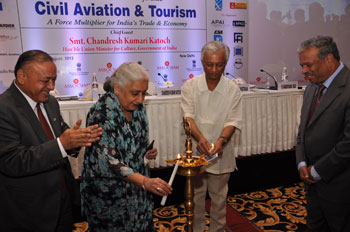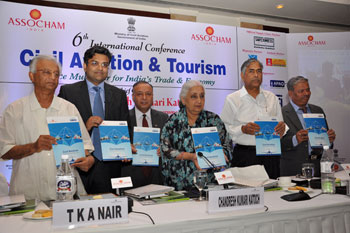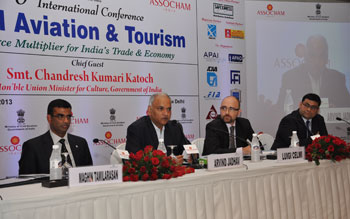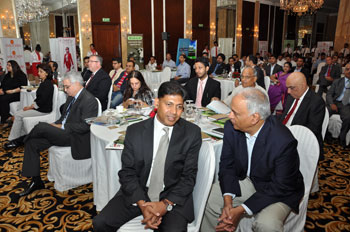INDIAN ARMED FORCES CHIEFS ON
OUR RELENTLESS AND FOCUSED PUBLISHING EFFORTS

SP Guide Publications puts forth a well compiled articulation of issues, pursuits and accomplishments of the Indian Army, over the years

I am confident that SP Guide Publications would continue to inform, inspire and influence.

My compliments to SP Guide Publications for informative and credible reportage on contemporary aerospace issues over the past six decades.
India to develop 50 new low-cost airports
At the Sixth ASSOCHAM International Conference on Civil Aviation and Tourism held in New Delhi on August 30, K.N. Srivastava, Secretary, Ministry of Civil Aviation (MoCA) informed that the government will set up 50 new low-cost airports this year and 50 next year






With the aim to boost to the civil aviation sector in India and increase air connectivity to Tier-II and Tier-III cities, the government has decided to set up 50 new low-cost airports this year and 50 next year. This was informed by K.N. Srivastava, Secretary, Ministry of Civil Aviation (MoCA) at the Sixth Associated Chambers of Commerce and Industry of India (ASSOCHAM) International Conference on Civil Aviation and Tourism held in New Delhi on August 30.
He further added that the low-cost airports will come up in 50 cities of Andhra Pradesh, Jharkhand, Bihar, Punjab, Uttar Pradesh, Arunachal Pradesh, Assam, Madhya Pradesh, Rajasthan and Maharashtra and the MoCA has called for a meeting of the Ministers and Secretaries of these states to finalise the policy of regional connectivity.
The conference “Civil Aviation and Tourism: A Force Multiplier for India’s Trade and Economy” saw the industry and experts come together to deliberate on the current and future scenario of civil aviation and tourism in India and discussed on measures to be taken to overcome the slowdown in the sector. K. Narayan Rao, Chairman, ASSOCHAM Civil Aviation Committee, said that the setting up of the Civil Aviation Authority and the new policies on civil aviation will help in the continuous journey of growth.
The Yes Bank knowledge report on civil aviation and tourism, titled: Civil Aviation Flying into Next Growth Orbit, was released on the occasion. The report stresses on the need for increased regional connectivity to boost up the domestic civil aviation industry.
Delivering her inaugural address, Chandresh Kumari Katoch, Minister for Culture, said that tourism, civil aviation and trade and commerce are inter-connected. “Cultures serve as the foundation on which the building of tourism can be built. But without good communication and connectivity, we will not be able to reach global audiences. Once we have the inflow of international tourists, there will automatically be an increase in trade and commerce.” In his keynote address, T.K.A. Nair, Adviser to Prime Minister of India, also emphasised on the need of all the three sectors to work together.
Best performance awards were given away to Ligare Voyages for being the most versatile company in aviation; SafeExpress for being the best air cargo logistics; Boeing for being the best global aviation company; IndiGo for being the best domestic airline; British Airways for the best international airline; and Frankfinn for being the best aviation training institute.
Guest of honour K.N. Srivastava informed that Navi Mumbai, Pune, Goa and Patna airports are facing capacity constraints, but Chennai does not suffer from any capacity constraint today. But in the next six-seven years, it can also face capacity constraints and hence the government is considering having an airport in Sriperumbudur. “In order to stimulate the air connectivity, airlines are expected to add around 370 aircraft worth $27.5 billion to their fleet by the year 2017,” said Srivastava.
“It is estimated that commercial fleet size shall reach 1000 from 400 today by 2020. To spur the growth of international air travel, the government has taken substantial steps to liberalise and grant traffic rights to Indian carriers to fly to several new destinations across the globe. There are 71 foreign passenger airlines operating in India at 25 airports with 1,655 flights per week. In addition, in the year 2012, there were 703 tourist charted flights that carried 1.30 lakhs passengers.”
Srivastava informed that the government is planning to invest more than $120 billion in the development of airports infrastructure and development of low cost airports across the country. “The government has taken significant measures for providing affordable air-connectivity to remote and interior areas of the country—the North-Eastern Region and Tier-II and Tier-III cities of India.”
The first session presided by S. Machendranathan, Special Secretary and Financial Adviser, MoCA, deliberated on the “Regulatory Challenges including Taxes and Duties”. H.S. Kohli, Former Director General of Civil Aviation, spoke on the limitations of the Directorate General of Civil Aviation (DGCA) and the need for changes and improvements keeping in view the major changes the industry has undergone in the last decades. He said that it has to be aligned with the industry and frequent improvements should be made depending on the requirements.
Amber Dubey, Partner and Head-Aerospace and Defence, KPMG, India, delved on the need to attract more foreign tourists keeping in view the current economy of the country. In order to improve domestic airlines service, he emphasised on the need for states to reduce taxes and more number of Greenfield airports, the development of which cost much less than Brownfield airports. S. Chockalingam, Chief Financial Officer, Shell MRPL Aviation Fuels and Services Limited expressed dissatisfaction at the current tax regime which is not uniform. J.K. Mittal, Co-Chairman, J.K. Mittal and Co, said that there is the need for accountability, uniform taxes and early resolution of pending cases. In his concluding remarks, Machendranathan said that our regulatory mechanism is quite robust and many steps are being taken for growth of civil aviation in India.
Session II on “Need for Regional and Remote Connectivity”, was chaired by Arvind Jadhav, Additional Chief Secretary, Tourism Department, Government of Karnataka. Avik Bhattacharya, Director, Business Development, Boeing India, said that the market has to go beyond the metros. He suggested that Indian Air Force and Indian Navy bases be used for civil aviation purpose also, non-scheduled operator’s permit (NSOP) holders flight schedules be published, route dispersal guidelines emphasise on remote connectivity, state government give tax incentives, airport charges be reduced and incentives be given to passengers. Luigi Celmi, President, ATR India, said that there is the need to increase movement from Tier II and III cities to Tier IV cities. “India is a vibrant market but we do not have the luxury of time. The global scenario will force us to hurry up.” Maghim Tamilarasan, Director, Rolls-Royce India Private limited, said that India has great prospects with growth in the number of people flying or aspiring to fly. Jadhav spoke at length about the civil aviation growth story in Karnataka and regional and remote connectivity.
The third session was on “Air Cargo Industry Scenario,” which was presided by Captain Kapil Chaudhary, Secretary, Airports Economic Regulatory Authority. Deepak Dadlani, Advisor, Air Cargo Agents Association of India, spoke about the constraints and roadblocks for the air cargo industry. He said that there is the need for cost efficient cargo terminals and India has good scope to be a hub. Pradeep Panicker, Chief Commercial Officer, Delhi International Airport Private Ltd presented the cargo operators point of view. Sandeep M. Bhatnagar, Joint Secretary (Customs), Central Board of Excise and Customs, also spoke on the occasion.





